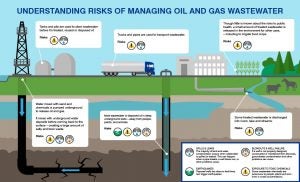By Adam Peltz and Nichole Saunders
As oil and gas production increases, so does the risk of toxic waste leaking to the environment. The massive amount of briny wastewater generated from oil and gas development can cause serious damage if it comes into contact with the public or our environment.
Consider what happened to the Johnsons, a 4th generation ranching family in New Mexico. More than 400,000 gallons of wastewater spilled on their ranch leaving a dead zone no longer viable to raise cattle or grow crops.
This is not an isolated incident. The Environmental Protection Agency says the vast majority of land and water contamination from oil and gas development is caused by surface spills and poorly constructed and maintained wells.
Pathways for Contamination
1) Well failure at production sites can create major problems for drillers and for the 17 million Americans who live within a mile of one of these wells. Poor design, cracked casing, or flawed cement work can cause dangerous well blowouts, and toxic leaks from malfunctioning wells can occur even after the well stops producing.
- Solution: States can significantly reduce the risk of a well failure by requiring operators to ensure wells are properly designed, constructed, maintained, and plugged, and by adequately enforcing those standards. Standards should be updated regularly to keep pace with emerging technologies and practices.
2) Wastewater storage systems that aren’t properly designed, constructed, monitored, and eventually closed and cleaned up are also a contamination risk. Images from the U.S. Geological Survey reveal how brine releases from poorly managed tank sites can wreak havoc on surrounding vegetation.
- Solution: Strong industry-wide standards and rules can help ensure operators are following the best maintenance and management practices for wastewater storage facilities. This includes smart engineering that accounts for possible failure, ensuring that construction adheres to design, and routine inspections, maintenance and other leading practices like using liners and leak detection.
3) Wastewater transport — whether by flowline, pipeline or truck – creates many opportunities for fluids to spill or leak, especially as operators increasingly transport larger quantities of wastewater longer distances for recycling. The more it moves around, the more likely a spill can occur.
- Solution: Regulators and industry must adhere to advanced design and construction standards for pipelines, and also improve monitoring and reporting requirements in order to quickly identify and remediate accidents after they occur. Better information on why, when, and how spills occur is a vital step in preventing them in the first place.
4) Disposal wells are usually considered one of the most economically and environmentally sound solutions for managing oilfield wastewater, but site-level malfunctions and improperly permitted disposal wells can contaminate groundwater, and increased disposal in some states has caused an uptick in small earthquakes.
- Solution: Ensure disposal wells meet proper construction standards, follow permit operating guidelines, and are regularly evaluated for integrity. To reduce injection-induced earthquakes, some states have successfully started to reduce injection volumes and rates, or even prohibit disposal wells altogether in areas near fault lines. Some states have also begun policing hydraulic fracturing operations, which are responsible for a relatively small portion of induced quakes.
5 ) Releasing wastewater onto roads, land and waterways can cause significant contamination if water isn’t treated to meet quality standards that need to be advanced. For example, one recent Penn State study found that releasing millions of gallons of wastewater – even if treated – can have long lasting impacts on the environment.
Wastewater can be intentionally released under existing permitting schemes in a number of ways. For example, under current laws, operators located west of the 98th Meridian can get permits to discharge wastewater into rivers or streams if the water is deemed “good enough” for agriculture and livestock. The problem is there is little agreement on what “good enough” means, and no set standard. In fact, we only have regulator-approved tests for identifying 25% of the 1600 chemicals that may be present in wastewater, which makes it difficult to set standards that can confidently protect the environment and public health.
- Solution: Additional research on the content of wastewater and water treatment technologies must be conducted to determine if oil and gas wastewater can be released on our soil or into fresh water sources without cause for concern.
6) Using oilfield wastewater to irrigate crops is a practice used in drought-stricken regions of California and being considered by other states and companies as well – especially as demand for water or disposal cost increases. Unfortunately oil and gas companies, regulators, and scientists don’t have the scientific evidence to confirm this practice poses no risk to public health or the environment.
- Solution: Further assessment of the risks of using oilfield wastewater for crop or livestock irrigation must be undertaken before it is more widely piloted or permitted. This includes learning more about the chemicals present in wastewater, as well as the potential toxicity of treated waste streams to crops, soil, livestock, as well as aquatic resources and human health. New potential ‘users’ of this wastewater, as well as regulators who may permit these practices, need better data to enable informed decisions in the future.
While many of these are familiar challenges for the oil and gas industry, others are just now emerging – in either case, attention and concern around these issues will only increase as drought and other environmental concerns plague many of the regions where oil and gas development is intense. If the industry works collaboratively with regulators and environmental scientists, we can address these problems while still supporting a reliable energy industry.
